Auto insurance is a critical aspect of responsible vehicle ownership, offering financial protection and peace of mind. However, many drivers remain with the same insurer for years without exploring other options. Regularly shopping for auto insurance can lead to significant benefits, including cost savings, improved coverage, and access to new discounts. As personal circumstances and driving habits change, reviewing and updating your policy to ensure it meets your current needs is essential.
Over the years of development, many inconsistencies and “myths” have clouded auto insurance companies’ practices. Debunking common myths about car insurance is vital for making informed decisions. Below, we give you helpful car insurance facts and debunk myths to help you maintain a good relationship with auto insurances.
The Importance of Regularly Shopping for Auto Insurance
Auto insurance is an essential component of responsible vehicle ownership, providing financial protection and peace of mind. However, many drivers stick with the same insurance provider for years without considering other options.
Regularly shopping for auto insurance can lead to significant benefits, including cost savings, better coverage options, and updated policies that reflect changes in your driving habits or personal circumstances.
Below are a few more reasons why personal auto insurance is critical.
Cost Savings
Insurance rates vary significantly between companies, and your current provider may not always offer the best deal. Regularly comparing quotes can reveal opportunities for substantial savings. Changes in your driving record, age, and vehicle type can all impact your premium, and shopping around ensures you’re not overpaying.
Improved Coverage
Your insurance needs can change over time. For example, you might purchase a new car, move to a different area, or reduce your daily commute. Regularly reviewing your policy helps ensure your coverage aligns with your current circumstances. You might find policies with better benefits, such as lower deductibles, higher limits, or additional protections like roadside assistance or rental car coverage.
Access to Discounts
Insurance companies frequently offer various discounts that you might not be aware of. By shopping around, you can discover and take advantage of these discounts. Common discounts include those for safe driving records, bundling multiple policies (such as home and auto), having certain safety features in your car, or maintaining a good credit score.
Staying Competitive
The auto insurance market is highly competitive, with companies constantly adjusting their rates and offerings to attract new customers. By regularly comparing your current policy with other options, you ensure that your provider remains competitive and continues to offer you the best possible rate.
Adaptation to Life Changes
Life changes such as marriage, retirement, or a new job can affect your insurance needs and premiums. Regularly shopping for insurance allows you to adapt your coverage to these changes, ensuring you remain adequately protected without overpaying.
Debunking Myths Surrounding Car Insurance
Myth #1: The Color of Your Car Affects Insurance Rates
A common myth is that car color influences insurance costs, often emphasizing red cars being costly. The color of your vehicle has no impact on your auto insurance premium. Insurers are more concerned with the make, model, body type, engine size, and age of the vehicle.
Myth #2: Coverage Is Always Automatic for New Cars
While certain insurance providers offer automatic coverage, this is not always true. Always check the agreement and required coverage with your provider.
Myth #3: Minimum Coverage Is Enough
Minimalistic, legally required coverage might seem appealing, but it might fail to protect from potential damages to the car. Therefore, considering a comprehensive policy is a solid investment.
Myth #4: Men May Not Necessarily Pay Higher Premiums
Although men, especially those under 25, are often considered riskier, multiple factors sway the scale regarding premiums. A responsible driver, irrespective of age and gender, could qualify for lower premiums.
Myth #5: Credit Rating Does Not Matter
Contrary to popular belief, credit ratings can impact insurance rates in most states, with poor credit leading to higher premiums.
Myth #6: Accidents Do Not Need to be Reported
If you encounter an accident, it’s best to report it because your insurer can still raise your premiums if another driver reports the accident. Unreported accidents can also make you appear as a dishonest driver.
Myth #7: Insurance Need Not Automatically Cover Outstanding Loans
Except for GAP coverage, most insurance policies cover the car’s market value at the time of the accident, regardless of the outstanding loan amount. Therefore, depending on the size of the loan and the car’s value, the insurance payout may not be enough to cover the loan’s balance.
Myth #8: Comprehensive Coverage of My Vehicle Will Cover Its Full Cost in Case of Total Loss or Theft
Actually, comprehensive coverage will only reimburse you for your car’s current value at the time of loss or theft. Due to the depreciation of car value over time, this reimbursement might not be enough to pay off a financed vehicle, leaving you in debt for a car you no longer own.
Myth #9: GAP Insurance Is an Unnecessary, Additional Cost
Not quite; GAP insurance, also known as guaranteed auto protection insurance, is essential for those who lease or finance their car. It covers the difference between the remaining amount you owe on your vehicle and its value at the time of total loss or theft, saving you from making payments for a car you can no longer use.
Myth #10: GAP Insurance Is Only Beneficial for New Car Owners
While GAP insurance is typically associated with new vehicles, it can also benefit used car owners. For instance, if you have purchased a year-old used car, you might still find value in Gap insurance.
It’s important to recognize the limitations of Gap insurance. It does not cover repossession costs, aesthetic touch-ups from wear and tear or accidents, and roadside assistance or towing. It strictly covers the difference between your car’s value at the time of loss and the remaining amount you owe.



